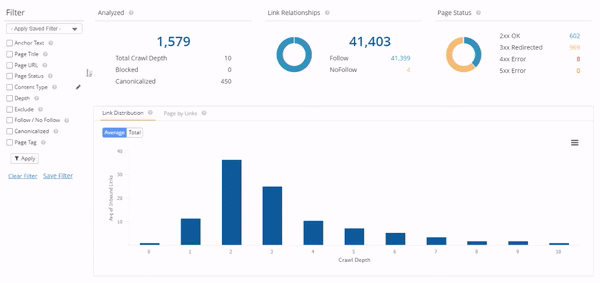What is Anchor Text?
Anchor text is the clickable text on a page that houses a hyperlink, either acting as an internal link to another page on the same site, or an external link pointing to a new domain altogether.
For the purpose of this article, we’ll be discussing anchor text optimization through the lens of an internal linking strategy, since an SEO has direct control over their own site’s internal links.
Did you notice that the words “internal linking strategy” act as the anchor text for the link in the previous sentence?
If so, you’re paying attention!
Based on the text used, a reader (or a search engine bot) can surmise that that link leads to a page about creating an interlinking strategy.
But not all anchor text is created the same, so not all anchor text holds the same weight. Our example gives good context as to where the link leads to, but that’s not the case for all anchor text.
Is Anchor Text Important for SEO?
Anchor text is a quick SEO tweak that shouldn't be overlooked.
Both users and search engines alike navigate through a website and find new discoveries with internal links, and anchor text (if optimized appropriately) offers a clue as to where that link leads to.
It’s not the largest optimization, but it’s still one piece of the recipe that makes Google understand your site and its contents. Google is further informed as to what the page is about and for which keyword it should rank.
More importantly, it clues in the users as to where they’re going. This small consideration does a lot for the user’s search experience.
The type of anchor text you use will impact how much more additional information you offer to users and search engines.
Types of Anchor Text
Ideally, your anchor text should explicitly be the target keyword of the page it leads to.
For example, if blog A links to blog B, and blog B has a target keyword of “things to do in chicago”, then the anchor text on blog A should be that specific query.
This is known as an exact match.
However, this can be challenging to do, as it all depends on the context of the copy and what makes the most sense. Fortunately there are other types of anchor text that can still inform the users as to where the link points.
For the following examples, let’s keep our example target keyword of “things to do in chicago”.
1. Exact Match
You already know about exact match. This is where the target keyword is the exact anchor text used.
Exact match anchor text: “things to do in chicago”
2. Phrase Match
The target keyword is included within the anchor text.
Phrase match anchor text: “the best things to do in chicago”
3. Partial Match
A partial match includes the target keyword in the anchor text, although not necessarily in the right order.
Partial match anchor text: “things in chicago to do”
4. Generic Anchor Text
Generic text offers no context as to where the link leads.
Generic anchor text: “Click here”
5. Branded Anchor Text
The anchor text is the name of the brand or publication in question.
Branded anchor text: “Time Out”
6. Naked Link
A naked link is simply a link typed out fully on a page. It’s not hyperlinked to any anchor text, rather, the URL itself acts as the anchor text.
Naked link: “www.timeout.com”
7. Image Anchor
This isn’t text, per se, but it still constitutes an anchor. This is where an image includes a link to another page.
In this case, search engines use the image’s alt text as the anchor text, since they can’t read images. Users would use the context of the image itself.
Issues With Anchor Text
Common anchor text issues include there being generalized text which provides no further context as to where the link leads (i.e. “click here”, “here”).
These general anchor texts should be avoided. Naked URLs should be avoided, too, as they don’t provide a positive user experience.
These issues lead to a missed opportunity to enhance the online search experience.
Anchor Text Best Practices
Anchor text best practices are really doing the exact opposite of the common issues mentioned. You don’t want general terms (or naked URLs) to serve as your anchor text.
In a perfect world, the exact match anchor text would be used for all internal link purposes, but the phrase match and partial match are acceptable, too.
The bottom line is that you want to target page relevance in your anchor text.
Auditing Your Anchor Text
You can (and should!) audit your anchor text to verify that they properly target the page relevance, and avoid the common issues mentioned (i.e. they’re generic or missing).
With SEO technology like seoClarity, it’s easier than ever to do it, even at scale.
Let me show you how our Internal Link Analysis can quickly uncover all the instances where internal anchor text is the generic word “here”.
It operates from the crawl data of your choice, which is gathered with Clarity Audits, our built-in SEO site crawler.
Since we’re looking for anchor text that is “here”, we use the filter column to the left to set the anchor text to “is”, and type in the phrase we’re looking for.

(seoClarity's Internal Link Analysis.)
We find 13 pages that use “here” as the anchor text!
That’s 13 missed anchor text opportunities.
It may not seem like much, but remember that it’s a small piece of the puzzle that makes a difference in the end.
When we navigate to one of the pages in question, we can verify that the anchor text is in fact the generic term “here”.

Conclusion
Anchor text is a quick and easy optimization win that offers added value to search engines and users alike. We recommend you analyze your anchor texts to see if they offer value, or if you’ve missed an easy SEO win!







Comments
Currently, there are no comments. Be the first to post one!